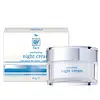What's inside
What's inside
 Key Ingredients
Key Ingredients

 Benefits
Benefits

 Concerns
Concerns

 Ingredients Side-by-side
Ingredients Side-by-side

Cyclopentasiloxane
EmollientGlycerin
HumectantCarthamus Tinctorius Seed Oil
MaskingPetrolatum
EmollientParaffinum Liquidum
EmollientGlyceryl Stearate
EmollientPEG-100 Stearate
Cetearyl Alcohol
EmollientNiacinamide
SmoothingDimethicone
EmollientMethylparaben
PreservativePropylparaben
PreservativeSodium Polyacrylate
AbsorbentTocopherol
AntioxidantDichlorobenzyl Alcohol
AntimicrobialCitric Acid
BufferingGlycerin
HumectantWater
Skin ConditioningRicinus Communis Seed Oil
MaskingCaprylic/Capric Triglyceride
MaskingSucrose Stearate
EmollientEthylhexyl Stearate
EmollientOlus Oil
EmollientDipentaerythrityl Hexacaprylate/Hexacaprate
EmulsifyingHydroxystearic/Linolenic/Oleic Polyglycerides
EmollientC20-40 Alcohols
EmulsifyingIsodecyl Neopentanoate
EmollientButylene Glycol
HumectantPhenoxyethanol
PreservativeMicrocrystalline Cellulose
AbsorbentCera Alba
EmollientPolysorbate 20
EmulsifyingEthylhexylglycerin
Skin ConditioningChlorphenesin
AntimicrobialCellulose Gum
Emulsion StabilisingParfum
MaskingCI 77891
Cosmetic ColorantXanthan Gum
EmulsifyingHydroxypropyl Cyclodextrin
MaskingChondrus Crispus Extract
Skin ConditioningSqualane
EmollientHelianthus Annuus Seed Oil
EmollientPEG-8
HumectantCaramel
Cosmetic ColorantTocopherol
AntioxidantRetinol
Skin ConditioningDaphne Odora Callus Extract
Skin ProtectingAscorbyl Palmitate
AntioxidantNicotiana Sylvestris Leaf Cell Culture
Skin ConditioningPlumeria Rubra Flower Extract
Skin ConditioningCI 15985
Cosmetic ColorantUbiquinone
AntioxidantLecithin
EmollientCI 19140
Cosmetic ColorantAscorbic Acid
AntioxidantCitric Acid
BufferingCI 17200
Cosmetic ColorantAscorbyl Tetraisopalmitate
AntioxidantBenzoic Acid
MaskingHexyl Cinnamal
PerfumingBenzyl Benzoate
AntimicrobialLinalool
PerfumingHydroxycitronellal
PerfumingCinnamyl Alcohol
PerfumingEugenol
PerfumingGlycerin, Water, Ricinus Communis Seed Oil, Caprylic/Capric Triglyceride, Sucrose Stearate, Ethylhexyl Stearate, Olus Oil, Dipentaerythrityl Hexacaprylate/Hexacaprate, Hydroxystearic/Linolenic/Oleic Polyglycerides, C20-40 Alcohols, Isodecyl Neopentanoate, Butylene Glycol, Phenoxyethanol, Microcrystalline Cellulose, Cera Alba, Polysorbate 20, Ethylhexylglycerin, Chlorphenesin, Cellulose Gum, Parfum, CI 77891, Xanthan Gum, Hydroxypropyl Cyclodextrin, Chondrus Crispus Extract, Squalane, Helianthus Annuus Seed Oil, PEG-8, Caramel, Tocopherol, Retinol, Daphne Odora Callus Extract, Ascorbyl Palmitate, Nicotiana Sylvestris Leaf Cell Culture, Plumeria Rubra Flower Extract, CI 15985, Ubiquinone, Lecithin, CI 19140, Ascorbic Acid, Citric Acid, CI 17200, Ascorbyl Tetraisopalmitate, Benzoic Acid, Hexyl Cinnamal, Benzyl Benzoate, Linalool, Hydroxycitronellal, Cinnamyl Alcohol, Eugenol
Ingredients Explained
These ingredients are found in both products.
Ingredients higher up in an ingredient list are typically present in a larger amount.
Citric Acid is an alpha hydroxy acid (AHA) naturally found in citrus fruits like oranges, lemons, and limes.
Like other AHAs, citric acid can exfoliate skin by breaking down the bonds that hold dead skin cells together. This helps reveal smoother and brighter skin underneath.
However, this exfoliating effect only happens at high concentrations (20%) which can be hard to find in cosmetic products.
Due to this, citric acid is usually included in small amounts as a pH adjuster. This helps keep products slightly more acidic and compatible with skin's natural pH.
In skincare formulas, citric acid can:
While it can provide some skin benefits, research shows lactic acid and glycolic acid are generally more effective and less irritating exfoliants.
Most citric acid used in skincare today is made by fermenting sugars (usually from molasses). This synthetic version is identical to the natural citrus form but easier to stabilize and use in formulations.
Read more about some other popular AHA's here:
Learn more about Citric AcidGlycerin is already naturally found in your skin. It helps moisturize and protect your skin.
A study from 2016 found glycerin to be more effective as a humectant than AHAs and hyaluronic acid.
As a humectant, it helps the skin stay hydrated by pulling moisture to your skin. The low molecular weight of glycerin allows it to pull moisture into the deeper layers of your skin.
Hydrated skin improves your skin barrier; Your skin barrier helps protect against irritants and bacteria.
Glycerin has also been found to have antimicrobial and antiviral properties. Due to these properties, glycerin is often used in wound and burn treatments.
In cosmetics, glycerin is usually derived from plants such as soybean or palm. However, it can also be sourced from animals, such as tallow or animal fat.
This ingredient is organic, colorless, odorless, and non-toxic.
Glycerin is the name for this ingredient in American English. British English uses Glycerol/Glycerine.
Learn more about GlycerinTocopherol (also known as Vitamin E) is a common antioxidant used to help protect the skin from free-radicals and strengthen the skin barrier. It's also fat soluble - this means our skin is great at absorbing it.
Vitamin E also helps keep your natural skin lipids healthy. Your lipid skin barrier naturally consists of lipids, ceramides, and fatty acids. Vitamin E offers extra protection for your skin’s lipid barrier, keeping your skin healthy and nourished.
Another benefit is a bit of UV protection. Vitamin E helps reduce the damage caused by UVB rays. (It should not replace your sunscreen). Combining it with Vitamin C can decrease sunburned cells and hyperpigmentation after UV exposure.
You might have noticed Vitamin E + C often paired together. This is because it is great at stabilizing Vitamin C. Using the two together helps increase the effectiveness of both ingredients.
There are often claims that Vitamin E can reduce/prevent scarring, but these claims haven't been confirmed by scientific research.
Learn more about Tocopherol